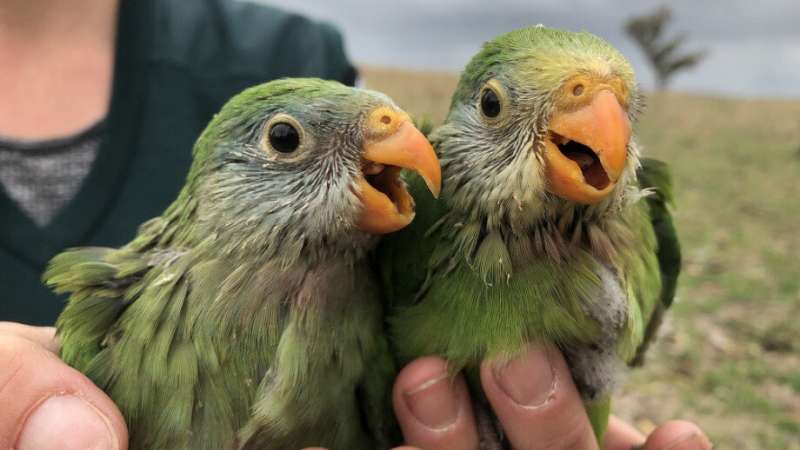This article has been reviewed according to Science X's editorial process and policies. Editors have highlighted the following attributes while ensuring the content's credibility:
fact-checked
trusted source
proofread
Canberra's superb parrots caught up in housing crisis

Just half a percent of the available tree hollows in Canberra's woodlands are suitable nests for superb parrots.
A new study by researchers at the Australian National University (ANU) and the ACT Government has found the search for a suitable nesting site can have a big impact on how many offspring the superb parrots are able to produce.
Superb parrots are a listed vulnerable species with a small resident population in Canberra.
Previously, ANU researchers have shown that these sleek green birds depend on tree hollows for nesting, but that their preferred nest sites are extremely rare.
This prompted lead researcher Dr. Dejan Stojanovic and his co-authors to ask whether pairs of parrots that monopolize nesting sites have an advantage when it comes to breeding success.
The study, published in Animal Conservation, shows that breeding pairs of superb parrots that successfully defended a suitable nesting site over multiple years produce more than double the offspring of unsuccessful pairs.
"Breeding pairs that can secure access to a good quality nest over time dominated the breeding output of Canberra," Dr. Stojanovic said.
Using genetic techniques to look at the relatedness of superb parrots in Canberra, they found that of the 181 superb parrots born over 5 years, 60% were the offspring of only 13 breeding pairs that monopolized preferred nest hollows.
The remaining 40% of births were attributed to 21 breeding pairs that bred only once during the five year study.
"Repeat breeders rarely switched their nesting site, showing that once the parrots find a good place to breed, holding on to that nest is critical for success," Dr. Stojanovic said.
The study raises important questions about superb parrot breeding and the longevity of the species.
Understanding why some breeding pairs only breed once and confirming whether one-time breeders die or disperse to other locations is crucial for understanding the conservation needs of the species.
"The lack of breeding by local nestlings is a worry, and also a surprise," Dr. Laura Rayner, co-author and Senior Ecologist with the ACT Parks and Conservation Service, said.
"We don't know what happens to young superb parrots after they leave their nests, but our genetic sampling shows that they are not breeding where they were born."
The research presents conclusive evidence of the importance of protecting nesting sites for superb parrot recovery.
"Our research highlights that access to suitable nesting hollows is critical for superb parrots. However, encroachment on nesting areas by suburbs and agriculture likely escalates competition for this rare and declining resource," Dr. Rayner said.
More information: D. Stojanovic et al, Reproductive skew in a Vulnerable bird favors breeders that monopolize nest cavities, Animal Conservation (2023). DOI: 10.1111/acv.12855
Provided by Australian National University




















